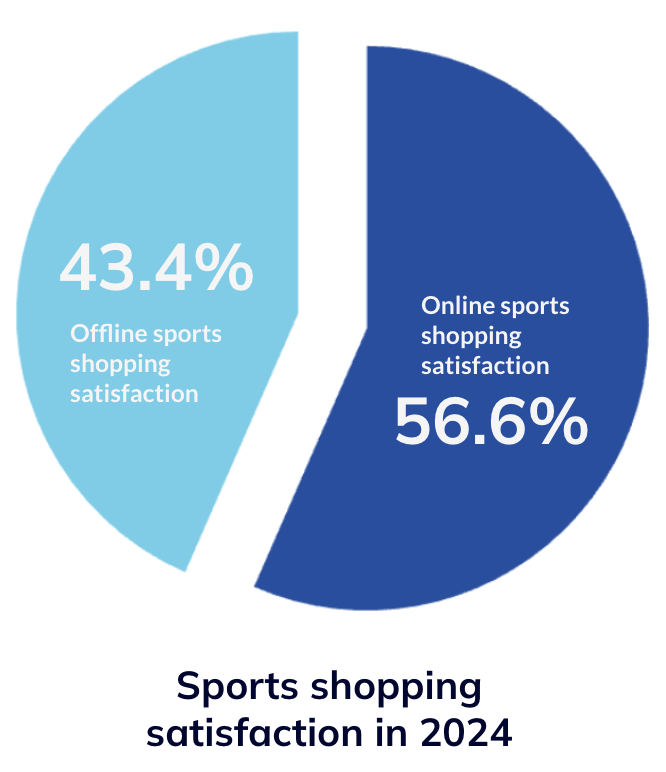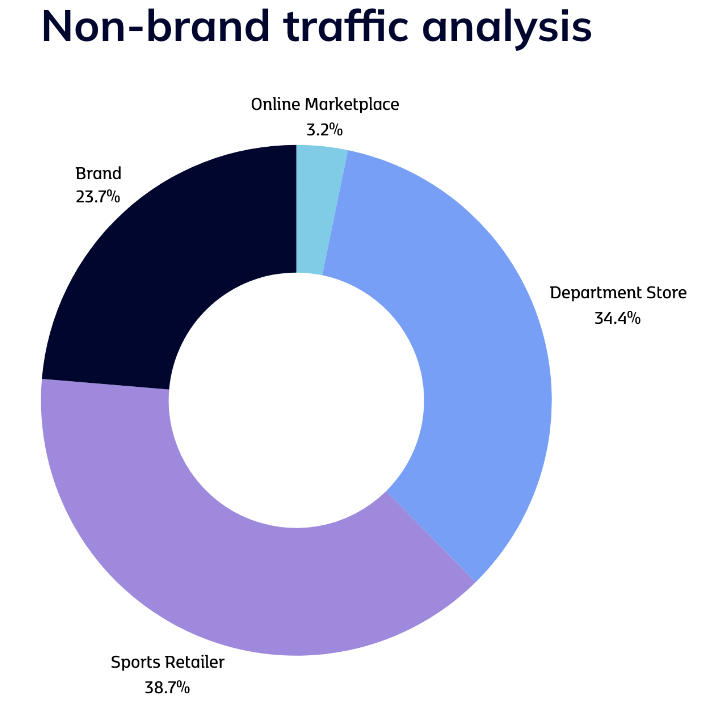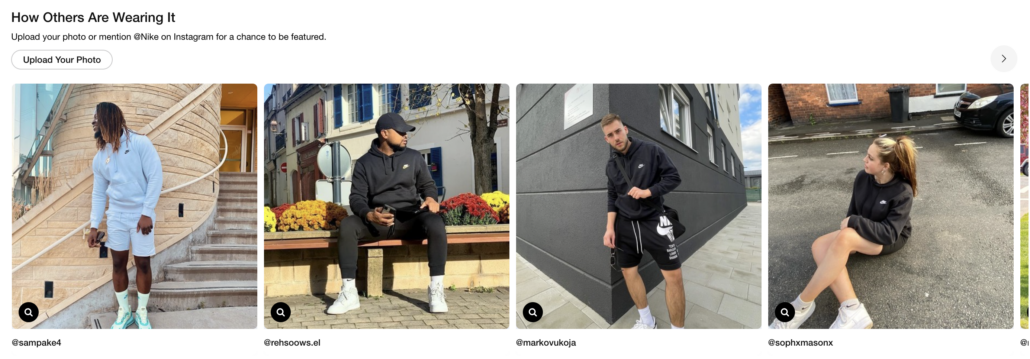The sportswear and athleisurewear industry is evolving rapidly, driven by shifts in consumer behaviour, technological advancements, and emerging trends. For ecommerce brands, staying ahead of these changes is crucial for capturing market share and building strong customer relationships. Our 2024 Ecommerce Sportswear and Athleisurewear Report highlights the top 10 key learnings that can help brands navigate this dynamic landscape, from embracing sustainability to leveraging the latest SEO strategies.
1. The Sportswear Market is Booming
The global sportswear market is poised for significant growth, expanding from $428.21 billion in 2021 to a projected $725.55 billion by 2031. This surge is largely driven by the increasing popularity of ecommerce, which has become a vital channel for sales, especially in the UK. Here, online sportswear sales are not only growing but are also outstripping the performance of physical retail stores, highlighting the critical importance of digital strategies for brands.

2. Direct-to-Consumer (DTC) is the Future
Top sportswear brands such as Nike, Adidas, and Puma are increasingly shifting towards a direct-to-consumer (DTC) model, which allows them to bypass traditional retail channels. This approach enables brands to forge stronger, more direct relationships with their customers while gaining greater control over the entire ecommerce experience. Additionally, DTC strategies provide valuable first-party data that is essential for personalizing marketing efforts and driving customer engagement. Adidas and Nike have been leading the way in DTC performance over the last 5 years.
3. Retailers and Marketplaces Still Dominate Non-Brand Traffic
Retailers and marketplaces continue to hold a commanding presence in the sportswear ecommerce space, capturing 77% of non-brand traffic. For individual brands, this dominance presents a challenge: to carve out a distinct identity and secure higher rankings for key search terms. To stand out, brands need to innovate their SEO strategies, focusing on niche keywords and unique content that can differentiate them from the broader retail landscape.

4. Seasonality Requires Agility
The sportswear industry is highly seasonal, with consumer demand and fashion trends shifting rapidly throughout the year. To stay competitive, ecommerce brands must be agile, ready to adjust their SEO tactics and marketing strategies in response to these seasonal changes. By aligning their campaigns with current trends and consumer behaviour, brands can better capture the attention of their target audience at the right time. We’ve seen brands reacting at lightning speed to search trends, and content themes emanating from the European Championships, Wimbledon, and the Paris Olympics games this summer to gain organic traction.
5. Visual Content is Crucial
In the sportswear market, where visual appeal plays a significant role in purchasing decisions, balancing SEO with engaging visual content is essential. Brands need to ensure that their websites are not only optimized for search engines, but also visually compelling enough to attract and convert customers. High-quality images, videos, and interactive content can enhance the shopping experience, making it easier for consumers to connect with the brand and its products. Nike have enjoyed rapid growth in this niche over the last 10 months, thanks in part to the high quality visual content on their PDP and category pages. Nike also do a fantastic job of leveraging UGC (user-generated content) on their product pages. A smart move; according to a research by Stackla 79% of people say user-generated content (like customer photos) highly impacts their purchasing decisions.

6. Gender-Neutral Sportswear is on the Rise
The growing demand for inclusivity in fashion is fueling the rise of gender-neutral sportswear collections, a trend particularly embraced by Gen Z. This segment is expected to grow at a compound annual growth rate (CAGR) of 6.5%, reflecting its increasing importance in the market. Brands like Nike, which have introduced gender-neutral athletic wear, are leading this movement, setting the stage for others to follow and capitalize on this evolving consumer preference.
7. Luxury Athleisure is Here to Stay
Luxury athleisure, which combines the comfort of athletic wear with the style of high-end fashion, is becoming a permanent fixture in the market. As consumers seek premium, stylish, yet comfortable clothing, this category is seeing rapid growth, spurred by high-profile collaborations between luxury and sportswear brands, like Gucci and Adidas. For ecommerce brands, this trend represents an opportunity to target a niche market with lower search volumes but higher conversion rates, focusing on luxury-oriented keywords and exclusive product offerings.
8. Sustainability is Non-Negotiable
Sustainability has emerged as a critical factor in consumer purchasing decisions, with 60% of consumers considering it an essential element in their choices. Leading brands like Adidas are responding by incorporating recycled materials into their products and promoting transparency in their supply chains. For ecommerce brands, embracing sustainability is not just about meeting consumer expectations but also about differentiating themselves in a competitive market, appealing to the growing segment of eco-conscious shoppers.

9. Answer Engine Optimization (AEO) is Critical
As search engines evolve, Answer Engine Optimization (AEO) is becoming increasingly important for brands aiming to capture traffic from AI-powered search results. Unlike traditional SEO, AEO focuses on optimizing content to directly answer user queries, often through structured Q&A formats and content that addresses specific user intents. Brands that excel in AEO, like Adidas, are better positioned to capture long-tail queries and secure valuable traffic that drives engagement and conversions.
10. Zero-Click Searches are a Double-Edged Sword
Zero-click searches, where users find answers directly on the search results page without clicking through to a website, present both challenges and opportunities for brands. While these searches can reduce organic traffic, securing featured snippets or “position zero” can significantly enhance brand visibility. Brands like Nike have successfully leveraged this strategy, particularly for sustainability-related queries, using zero-click searches to reinforce their brand values and connect with eco-conscious consumers in a meaningful way. By adopting Q&A formatting to provide detailed and relevant content, sites can secure “position zero” which can increase visibility, clicks and brand recognition.
As the sportswear and athleisurewear market continues to grow, ecommerce brands face both challenges and opportunities in their quest to stand out. By understanding and applying these top 10 key learnings, brands can position themselves for success in a competitive environment. Whether it’s capitalizing on emerging trends like gender-neutral fashion or optimizing for the latest SEO developments, these insights provide a roadmap for thriving in the ever-evolving ecommerce landscape.Are you looking to gain an edge in this competitive industry? At Re:signal, we can help. Our experienced teams can provide analysis of your ecommerce website, and recommendations for improvement based on the latest SEO information available. Contact us today for a tailored analysis.



